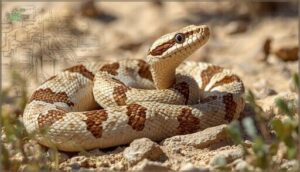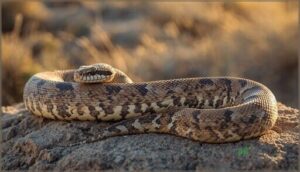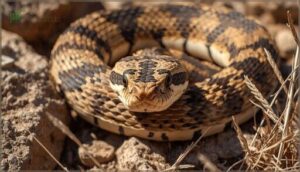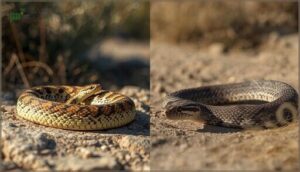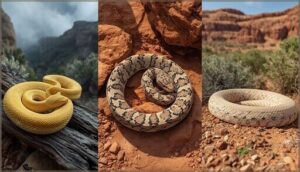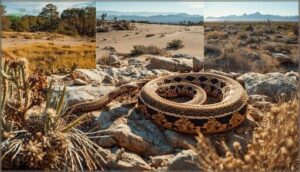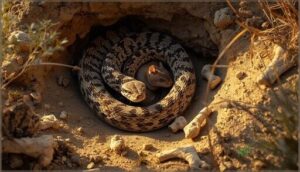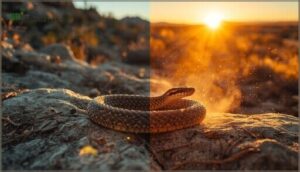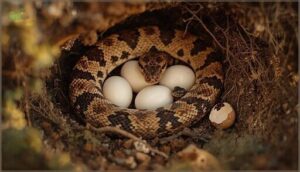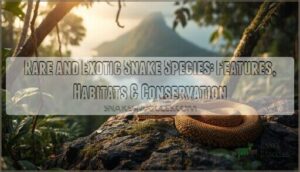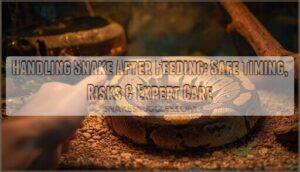This site is supported by our readers. We may earn a commission, at no cost to you, if you purchase through links.
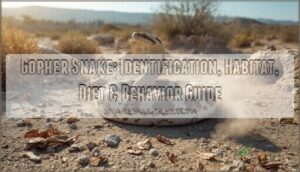
You’re hiking a sun-baked trail when a loud hiss erupts from the grass ahead—a thick-bodied serpent coils defensively, tail vibrating against dry leaves in an unmistakable rattle. Your heart pounds as you freeze, convinced you’ve stumbled upon a rattlesnake. But look closer: there’s no rattle, just a masterful bluff. You’ve just encountered Pituophis catenifer, the gopher snake, one of North America’s most accomplished mimics and effective rodent hunters.
These muscular constrictors stretch up to nine feet long and inhabit everything from coastal chaparral to desert scrubland, where they patrol burrows and rock crevices hunting mice and ground squirrels.
Understanding how to identify these beneficial serpents—and distinguish them from their venomous lookalikes—can transform fear into fascination and help you recognize an important ally in rodent control.
Table Of Contents
- Key Takeaways
- Gopher Snake Identification
- Habitat and Geographic Range
- Diet and Hunting Behavior
- Behavior and Life Cycle
- Reproduction and Conservation Status
- Frequently Asked Questions (FAQs)
- How poisonous is a gopher snake?
- Are gopher snakes good to have in your yard?
- What happens if you get bit by a gopher snake?
- What do you do if you see a gopher snake?
- What time of day do gopher snakes come out?
- Is it good to have gopher snakes in your yard?
- How to tell if it’s a gopher snake?
- What is a common name for a gopher snake?
- Are gopher snakes venomous?
- What is a Pacific gopher snake?
- Conclusion
Key Takeaways
- Gopher snakes (Pituophis catenifer) are nonvenomous constrictors reaching up to 9 feet that defend themselves by mimicking rattlesnakes through tail vibrations and hissing, but they lack actual rattles and possess round pupils instead of vertical slits.
- These reptiles consume over 80% rodents in their diet and can eat up to 1,000 pest animals annually, making them valuable allies for natural pest control in agricultural and residential areas.
- You can distinguish gopher snakes from rattlesnakes by checking for keeled scales, a blunt nose, round pupils, slender body shape, and the absence of a segmented rattle at the tail tip.
- Despite their “Least Concern” conservation status with populations exceeding 1 million, gopher snakes face significant threats from road mortality, habitat fragmentation, and human persecution due to mistaken identity with venomous species.
Gopher Snake Identification
Identifying a gopher snake correctly can protect both you and the snake from unnecessary conflict. These nonvenomous reptiles often get mistaken for their dangerous cousins, but once you know what to look for, the differences become clear.
Knowing how to identify a gopher snake protects both you and this harmless reptile from dangerous misunderstandings
Let’s break down the key features that’ll help you recognize a gopher snake in the wild.
Scientific Classification and Common Names
You’ll find the gopher snake classified scientifically as Pituophis catenifer, a member of the Colubridae family within order Squamata. Understanding its taxonomy studies and genus classification helps with accurate species identification across North America.
- Scientific name: Pituophis catenifer (Blainville, 1835), class Reptilia
- Common names: Bullsnake, Pacific gopher snake, coast gopher snake, western gopher snake
- Genus: Pituophis, derived from Ancient Greek meaning “pine snake”
- Recognized subspecies: Nine variations including P. c. sayi and P. c. deserticola
- Phylogenetic analysis: Molecular studies reveal distinctions between eastern and western populations
The gopher snake’s habitat and distribution can be further understood by studying its geographic range details.
Physical Characteristics and Size
You’ll recognize gopher snakes by their sturdy, muscular build and impressive body length ranging from 4 to 9 feet, though most adults measure between 4 to 5 feet. Their physical characteristics include 27 to 37 rows of strongly keeled scale patterns at midbody, a relatively large head shape with a narrow neck, and a distinctive slim tail structure without rattles. These snake species description features aid in accurate gopher snake identification.
Gopher snakes are often found in areas with wildlife conservation efforts, which help protect their habitats.
Coloration and Distinctive Markings
Beyond their impressive size, you’ll notice gopher snakes display striking color patterns ranging from yellowish to sandy brown, adorned with 33 to 66 dark blotches along their backs. Their head markings include three distinctive dark bands—one between the eyes, one below each eye, and angled stripes to the jaw.
These snake behavior and defense features create effective mimicry tactics resembling rattlesnakes. Their keeled scale texture and regional camouflage strategies help them blend into diverse habitats, from desert sands to woodland floors.
Gopher Snake Vs. Rattlesnake Differences
While gopher snakes master rattlesnake mimicry through tail vibrations and defensive postures, you can distinguish them by key differences.
Gopher snakes are nonvenomous constrictors with round pupils and slender bodies reaching 6-9 feet, while rattlesnakes possess venomous fangs, vertical pupils, and stockier frames of 3-6 feet.
The most reliable identifier? Rattlesnakes have actual rattles—gopher snakes just shake their tails for convincing rattle imitation.
Subspecies and Regional Variations
Six subspecies span North America, each shaped by geographic isolation and regional adaptations. You’ll encounter the Pacific gopher snake (Pituophis catenifer catenifer) along the West Coast, the Sonoran gopher snake in desert terrain, and the Great Basin gopher snake in dry interior valleys.
Color morphs range from yellow-brown coastal forms to darker desert variations, reflecting subspecies classification based on genetic variations and environmental pressures.
Habitat and Geographic Range
Gopher snakes inhabit a remarkably wide geographic range across North America, from southern Canada through the western United States into northern Mexico. You’ll find them thriving in diverse environments—from arid deserts and coastal dunes to dense forests and suburban gardens.
Understanding where these adaptable reptiles live and how they use their surroundings helps you recognize their ecological importance and predict where you’re most likely to encounter them.
Native Regions and Distribution
You’ll find gopher snakes thriving across an impressive North America range, from southwestern Canada down to northern Mexico. Their habitat distribution reflects striking climate adaptation, with eleven regional subspecies occupying distinct territories. Geographic range varies notably:
- Pacific gopher snake inhabits coastal regions from Oregon through California at low elevations
- Great Basin subspecies dominates Nevada, Utah, and western Colorado’s arid landscapes
- Sonoran gopher snake ranges through southwestern deserts and northwestern Mexico
- Bullsnake extends from Alberta to Texas across central grasslands
- Island subspecies remain isolated on California’s Channel Islands and Baja California islands
Distribution patterns demonstrate exceptional habitat diversity across temperate and semi-arid zones.
Preferred Ecosystems and Environments
Across habitat distribution patterns, you’ll discover gopher snakes flourish in remarkably diverse landscapes. Their habitat diversity spans deserts, prairies, woodlands, chaparral, and cultivated fields, demonstrating superior environmental adaptation. Their microhabitat selection includes burrows, rock fissures, and scattered shrub cover within semi-arid terrain.
Ecosystem preferences center on open grasslands with loose, well-drained sandy soils where temperatures range from 75°F to 90°F, supporting ideal thermoregulation and foraging success across these animal habitats.
| Ecosystem Type | Key Landscape Features |
|---|---|
| Deserts & Semi-arid Zones | Sparse vegetation, sandy substrate, scattered rocks |
| Prairies & Grasslands | Open meadows, grassy slopes, loose gravel soils |
| Woodlands & Agricultural Areas | Forest edges, field margins, undeveloped lots |
Adaptation to Urban and Agricultural Areas
You’ll spot gopher snakes thriving where cities meet wilderness—these adaptable reptiles flourish in urban habitat zones and farmlands rich with prey. Studies confirm they’re the second most commonly removed snakes in metropolitan areas, yet their presence benefits agricultural adaptation by controlling rodent populations.
Snake behavior shifts in human-modified landscapes: they nest in compost piles, exploit irrigation systems, and even select crop soils for egg-laying when conditions support reproduction.
Burrow and Den Usage
Gopher snakes spend up to 90% of their life underground—a survival strategy rooted in burrow architecture and den selection. You’ll find them occupying abandoned rodent burrows, which they transform into refuges for thermoregulation and hibernation patterns.
- Preferred dens include pocket gopher tunnels and rocky outcrops in grassland habitats
- Hibernation patterns show 58% site fidelity, with snakes returning to proven overwintering locations
- Soil turnover from burrowing activity facilitates ecosystem engineering across gopher snake habitats
- Communal denning occurs in roughly 24% of sites during cold months
Diet and Hunting Behavior
Gopher snakes are carnivorous constrictors that rely on a varied diet to survive across their wide range. Their feeding habits reflect both their opportunistic nature and their vital role in controlling pest populations.
You’ll find that their hunting techniques and prey preferences shift based on season, location, and what’s available in their environment.
Primary Prey and Feeding Habits
Understanding what fuels these skilled hunters reveals their ecological importance. Rodents dominate over 80% of their diet, with deer mice leading as the most frequent prey item. Bird eggs and ground-nesting birds contribute roughly 5–10% seasonally. Lizards appear in about 7% of cases, while frogs rarely exceed 2%. This prey diversity showcases impressive dietary adaptations.
| Prey Type | Diet Percentage |
|---|---|
| Rodents | 80%+ |
| Birds/Eggs | 5–10% |
| Reptiles | ~7% |
Adult gopher snakes generally feed every 7–10 days during warmer months, consuming meals equal to 8–15% of their body weight. These feeding patterns shift with seasonal prey availability, making them invaluable allies in rodent control across farmlands and urban spaces alike.
Constriction and Hunting Techniques
These nonvenomous constrictors rely on advanced prey detection—tongue flicking increases 200% when rodents are near. You’ll find them stalking slowly for 15 minutes, then striking within 0.6–1.2 seconds.
Their constriction methods apply 32 kPa of pressure, halting circulation in just 15 seconds.
Hunting strategies blend ambush tactics with active pursuit, achieving 72% success during daylight when snake camouflage works best in varied terrain.
Seasonal Diet Variations
Beyond ambush precision lies another adaptation you’ll appreciate: seasonal prey shifts that keep these reptiles thriving year-round. Your local gopher snake’s diet changes dramatically with temperature and prey availability. Spring prey includes juvenile rodents and bird eggs (11.9% of diet), while summer feeding peaks with mammals comprising 74.8% of intake. Autumn diet prioritizes energy-rich mature rodents before winter brumation halts feeding for four months. Regional variation means coastal populations differ from desert dwellers—smaller snakes target lizards while adults hunt larger mammals.
Seasonal Feeding Patterns:
- Spring – Young ground squirrels and cottontail rabbits dominate, with eggs from nesting birds supplementing the reptile diet and nutrition needs
- Summer – Peak consumption period when snake diet diversity increases with active burrow raiding for rodents
- Autumn – Larger, calorically dense prey selected as gopher snake diet shifts toward fat accumulation
- Winter – Feeding ceases during brumation in cold regions, though milder climates allow occasional activity
- Geographic Factors – Local prey cycles and habitat determine whether your snake consumes more amphibians, lizards, or mammals
Role in Rodent Control
These appetite shifts translate into meaningful pest management benefits for your land. You’ll find that a single gopher snake patrolling your property consumes enough rodents—ground squirrels (27.9% of diet), cottontail rabbits (37.1%), and woodrats (18.6%)—to reduce crop damage and disease transmission.
Their ecosystem balance contributions support agricultural benefits through natural predator-prey dynamics that outperform chemical controls while maintaining habitat and distribution patterns essential for wildlife conservation and snake conservation efforts.
| Rodent Population Impact | Economic Value |
|---|---|
| Reduces pest density by deterring activity | Decreases crop loss expenses |
| Accesses burrows traps can’t reach | Lowers rodenticide costs |
Behavior and Life Cycle
Gopher snakes follow distinct daily rhythms and seasonal patterns that shape their survival strategies. You’ll notice they’ve developed fascinating defensive tactics and movement abilities that help them thrive across diverse landscapes.
Understanding their behavioral patterns—from temperature regulation to how they interact with their environment—reveals why these reptiles succeed in so many habitats.
Daily and Seasonal Activity Patterns
You’ll notice gopher snake behavior shifts dramatically with temperature and season. These serpents demonstrate primarily diurnal behavior during mild weather, basking in sunlight to reach ideal body temperatures between 75-90°F.
Their activity cycles adapt throughout the year:
- Spring and summer bring peak activity as they emerge from winter dormancy
- Late fall through March triggers hibernation in underground burrows
- Nocturnal patterns develop during extreme heat to avoid dangerous temperatures
Thermoregulation drives these seasonal migration patterns between active hunting and dormancy periods.
Defensive Behaviors and Mimicry
When threatened, you’ll observe gopher snakes deploying impressive defensive behaviors centered on rattlesnake mimicry. Their tail mimicry involves rapid vibration in dry vegetation, producing rattlesnake-like sounds for predator avoidance.
Defensive posturing includes head flattening into triangular shapes, loud hissing, and bluff strikes in S-shaped coils.
Snake camouflage provides initial protection, while threat displays combining visual and auditory signals effectively deter predators without venom.
Thermoregulation and Basking
As ectothermic reptiles, gopher snakes rely on basking strategies to achieve temperature regulation. You’ll find them positioning on sun-exposed rocks or ground, seeking thermal gradients between 85°F basking zones and 70-75°F cooler areas. UVB exposure during 10-14 hour photoperiods aids vitamin D synthesis and metabolic function.
Environmental adaptation drives their seasonal thermoregulation—increasing basking duration in cooler months while adjusting snake behavior and ecology patterns for peak physiological performance within ecosystem dynamics and balance.
Climbing and Burrowing Abilities
Gopher snake characteristics reveal striking adaptability through dual locomotion strategies. You’ll observe their climbing prowess on rough-textured surfaces—scaling walls and trees to reach bird eggs and nestlings—while their pointed snout aids subterranean navigation through existing burrows.
Their behavioral repertoire includes:
- Tree climbing for vertical hunting opportunities
- Burrow architecture modification for thermoregulation
- Snake agility in diverse snake habitat and distribution zones
This versatility enhances wildlife management and ecology applications.
Reproduction and Conservation Status
Understanding how gopher snakes reproduce and where they stand regarding conservation gives you a complete picture of their life cycle and current status in the wild.
You’ll see how these snakes breed, develop from eggs to adults, and interact with human environments.
Here’s what you need to know about their reproduction, longevity, and the conservation challenges they face.
Breeding Season and Mating Rituals
During the breeding season from June to August, male gopher snakes actively seek receptive partners, engaging in fascinating courtship rituals. Snake attraction is primarily driven by chemical signals—females emit skin secretions that guide males to mating opportunities. This period marks the only significant social interaction in the gopher snake life cycle.
Understanding gopher snake reproduction reveals their polygynandrous reproductive strategies, where both sexes mate with multiple partners during the mating season. Males compete for dominance through ritualistic combat wrestling, intertwining their bodies in dramatic matches. Winners often practice mate guarding to deter rivals.
| Reproductive Aspect | Key Details |
|---|---|
| Breeding Season | June to August annually |
| Sexual Maturity | Males: 1.5-2 years; Females: 4 years |
| Mating System | Polygynandrous (multiple partners) |
| Male Competition | Ritualistic combat wrestling |
| Female Signaling | Chemical pheromone secretions |
Egg-Laying and Incubation
After successful mating, you’ll witness oviparous reproduction unfold as females seek protected nesting sites for their eggs. Gopher snake reproduction involves laying clutches between June and July, usually depositing 2-24 leathery-shelled eggs in abandoned burrows or beneath rocks. The incubation period spans 65-75 days, with embryo development heavily influenced by ambient temperature.
- Egg clutch size averages 7-8 eggs but varies based on female size and age
- Nesting sites include mammal burrows, decaying logs, and moist soil providing stable conditions
- Incubation period ranges 64-79 days depending on environmental temperature fluctuations
- Embryo development accelerates at ideal temperatures of 26-28°C (79-82°F)
- Hatchling care is nonexistent—females abandon clutches immediately after deposition
Hatchling Development and Lifespan
After those eggs hatch, you’ll observe hatchlings measuring 12-14 inches that face the world entirely alone. Growth patterns accelerate during the first three years, adding roughly 14.7 cm annually as juveniles master hunting through constriction. Predation threatens survival rates, though many reach sexual maturity—females at 3-5 years, males earlier at 1.5-2 years—with wild lifespans averaging 12-15 years.
| Development Stages | Timeline |
|---|---|
| Hatchling Size | 30-35 cm (12-14 inches) |
| Sexual Maturity (Female) | 3-5 years |
| Average Wild Lifespan | 12-15 years |
Conservation Status and Human Interaction
Beyond lifespan considerations, you’ll find gopher snakes classified as “Least Concern” by the IUCN, with populations exceeding 1,000,000 individuals. Yet this conservation status doesn’t mean they’re safe everywhere—road mortality claims many lives, while pesticide impact and habitat loss threaten local populations.
Human education remains critical, as mistaken identity leads to unnecessary killings. Wildlife conservation efforts now emphasize habitat preservation to guarantee their ecological role continues.
Threats and Protection Efforts
Despite their conservation status, gopher snakes face serious threats. Habitat fragmentation from urban development destroys their dens, while road mortality kills reproductive adults migrating between sites. Human persecution continues due to mistaken rattlesnake identity.
Conservation strategies now include legislative protection through Canada’s Species at Risk Act, wildlife habitat designations, and ecosystem management practices. These biodiversity efforts balance predator-prey dynamics while addressing habitat loss through stewardship agreements.
Frequently Asked Questions (FAQs)
How poisonous is a gopher snake?
Gopher snakes are completely nonvenomous. You won’t face any venom-related risks from their bites.
These constrictors rely on physical force, not toxins, to subdue prey like rodents.
Are gopher snakes good to have in your yard?
Having these non-venomous hunters in your yard delivers natural pest control benefits, balancing the ecosystem and limiting rodents.
Their quiet presence signals a healthy habitat and encourages wildlife coexistence—a win for effective yard management and wildlife conservation.
What happens if you get bit by a gopher snake?
Think of a thorn’s prick: a gopher snake bite leaves shallow punctures, mild pain, redness, and swelling, but no snake venom.
Quick first aid and sensible wound care—plus good bite prevention—make full recovery certain, with no lasting harm.
What do you do if you see a gopher snake?
If you see one, give it room—don’t corner or handle it. Observe quietly to gauge its defensive reactions. Respectful encounter protocols promote coexistence and wildlife conservation, reducing risk while allowing you to witness gopher snake behavior safely.
What time of day do gopher snakes come out?
Like dancers adjusting to the spotlight, these snakes shift between Diurnal Patterns, Nocturnal Behavior, and Crepuscular Activity. You’ll spot them basking or hunting at dawn, dusk, or night, depending on temperature and seasonal Daily Cycles for Thermal Regulation.
Is it good to have gopher snakes in your yard?
You’ll find real Pest Control Benefits with gopher snakes in your yard—they consume up to 1,000 rodents annually.
Wildlife Coexistence fosters Ecological Balance while enhancing Yard Safety, since they’re nonvenomous and rarely cause Snake Encounters.
How to tell if it’s a gopher snake?
Identifying a snake can feel as tricky as spotting camouflage in tall grass. You’ll notice keeled scales, round pupils, a blunt nose, and dark blotches on lighter backgrounds—key gopher snake characteristics distinguishing them from rattlesnakes.
What is a common name for a gopher snake?
You’ll hear several regional nicknames for Pituophis catenifer—“bullsnake” dominates central areas, while “Pacific gopher snake” identifies western subspecies.
Local terminology includes “blow snake” and “Henry snake,” though standardized classification remains most reliable.
Are gopher snakes venomous?
No, gopher snakes are entirely nonvenomous reptile species. They lack venom glands and produce no toxins.
Snake bites from this species cause only minor pain, with zero systemic toxicity levels recorded despite their defensive mechanisms.
What is a Pacific gopher snake?
The Pacific gopher snake (Pituophis catenifer catenifer) represents the nominotypical subspecies within Reptile Diversity studies.
It showcases Species identification and classification through its distinctive keeled scales and saddle-patterned dorsal markings across western North American ecosystems.
Conclusion
The very snake that sends hikers scrambling often guards their gardens from the rodents that would destroy them. Once you learn to recognize the gopher snake’s blunt head, keeled scales, and vibrating tail—minus the rattle—you won’t see a threat.
You’ll see a tireless hunter restoring balance to disrupted ecosystems. That hiss isn’t a warning to flee; it’s an invitation to look closer, to appreciate the elegant deception that keeps both serpent and observer safe.

